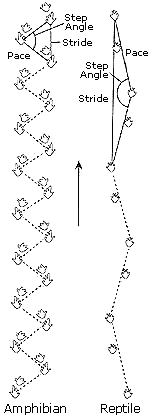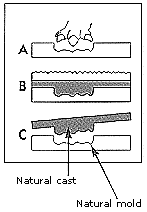    |
Science of Trackways - Ichnology"There is no branch of detective science which is so important and so much neglected as the art of tracing footsteps," -- Conan Doyle, creator of Sherlock Holmes, 1891.
Trackways are indisputable evidence of the posture and locomotion of the track maker - how they stood, walked, ran, or even swam. Scientists can use a trackway to help identify what type of animal made it. For example, amphibian trackways are broad and marked by a short stride, indicating the inefficient locomotion of these creatures on land. The trackways of reptiles generally are narrower and the stride longer than in the case of amphibian trackways, indicating more efficient locomotion. It is possible to distinguish the major groups of animals based on characteristic foot shapes, but it is difficult, if not impossible, to identify exactly what animal made a particular footprint. (One of the difficulties is that foot bones are small and rarely found.) For this reason, trackways are given their own names. Animals known by their footprints are called ichnofauna. Often, the name of the animal and the name of the trackway it made are different.
The speed of the animals can be calculated from the pattern and spacing of its footprints. Trackways also tell us about the environment of the track makers. In particular, the depths of tracks are good indicators of the water content of the soils, but they can also be used to determine the slope of the ancient landscape, the position of an ancient shoreline and, in cases where they were made underwater, current direction. Often, trackways occur in mudflats around the margins of lakes.
In order for an ancient animal to leave its track, conditions had to be ideal, both before and after it passed by. The ground had to be soft. Usually it was a muddy surface. The weight of the animal impressed the footprint into the muddy ground (A). The sun then baked the footprint until it dried out and became hard. Then the tracks must be filled with another layer of sediment (B). The difference in consistency between the two layers is important in preserving the trackway. Eventually, the trackway was covered by many layers of sand and mud. The weight of this material turned the mud and sand into stone over many millions of years. In a reversal of the process, erosion by water and wind, exposed the footprints. The sunken part of the footprint is called a natural mould. Natural casts are the raised material that originally filled in the footprint. The cast becomes apparent when the two layers of stone split apart (C). |
 This statement might well be applied to ichnology,
the science of fossil trackways and traces. Tracks are much more abundant than bony
remains and, in many cases, extinct animals are known only from their trackways. Fossil
preparator
This statement might well be applied to ichnology,
the science of fossil trackways and traces. Tracks are much more abundant than bony
remains and, in many cases, extinct animals are known only from their trackways. Fossil
preparator  Trackways offer unique and important insights into the behavior of extinct
animals. They reveal details about the lives of ancient animals that are not obvious from
skeletal remains. The frequency of tracks can serve as a census of the community and offer
a glimpse of the ecosystem. Tetrapod trackways weaving between the Walchia stumps
at Brule are a good example of this.
Trackways offer unique and important insights into the behavior of extinct
animals. They reveal details about the lives of ancient animals that are not obvious from
skeletal remains. The frequency of tracks can serve as a census of the community and offer
a glimpse of the ecosystem. Tetrapod trackways weaving between the Walchia stumps
at Brule are a good example of this. Making Tracks
Making Tracks